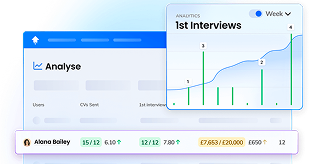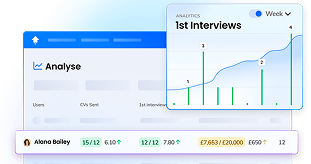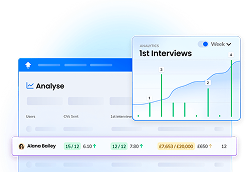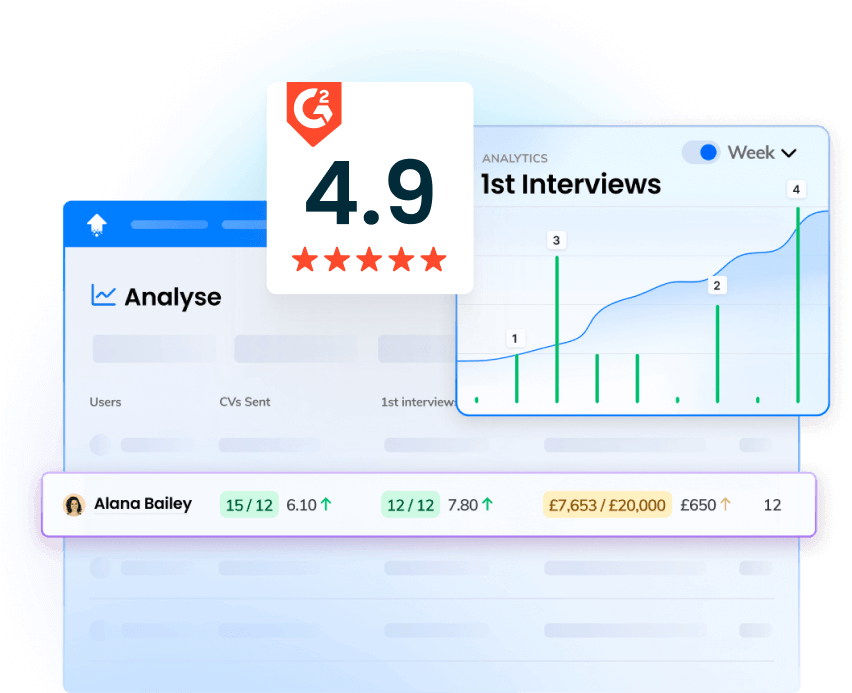The Anatomy of a Recruitment Pipeline
The purpose of recruitment pipelines is to help recruiters manage an efficient hiring process.
It gives you the data breakdown you need to set goals and track progress towards these targets.

Your pipeline overview will also flag any issues with your recruitment processes so you can swiftly attend to them.
Here, we will take you through the different stages of the recruitment pipeline to include in your recruiting pipeline template and explain what happens at each stage.
Stage 1: Jobs Added
Sitting at the beginning of the pipeline, the ‘Jobs Added’ stage is when a recruitment agency wins a new job to recruit for.
This is where you kick off the recruitment process, delving into your talent pool, identifying potential applicants through sourcing channels, and collaborating on job descriptions and compensation packages.
Looking at ‘jobs added’ in your recruitment pipeline reveals a few key things.
First and foremost, it speaks to the health of your pipeline—a low number of jobs added suggests you need to make more BD calls and build relationships with potential customers.
But sometimes, if this metric is low, it’s because businesses are struggling to stay afloat, are making cutbacks, or have low confidence in the market.
Expect the number of jobs added to fluctuate seasonally.
For instance, December is traditionally a quiet time for new jobs coming to market as businesses wind down towards the end of the year.
This makes it a great time to double down on client work to win more jobs.
Furthermore, OneUp research revealed a very quiet Q1 for jobs added in 2023, but this trended up as the year progressed — suggesting an improved economic climate heading into 2024.
Stage 2: CVs Sent
CVs sent is the number of CVs that have been sent for any open role.
This is when you have sourced a candidate, vetted their CV, matched them to the open role, and then sent their CV to the client.
In other words, you have been able to refer qualified candidates.
CVs sent is a good indication of the health of your talent pipeline.
If your CVs sent rate is unusually low, it suggests you're struggling to find qualified candidates.
In this case, you should work on widening your talent pools or identifying new sources.
It could also indicate that the job description or compensation package simply isn’t attractive, at which point negotiations with the client are necessary.
But a high rate of CVs sent is not necessarily good news either.
It could mean that you're submitting less qualified candidates in a bid to fill a role quickly without considering quality or that you've got an incredibly picky client.
Either way, CVs sent is an important stage of the hiring pipeline to keep an eye on as an abnormally high or low rate typically means you’re struggling to fill the role.
Remember that the CVs sent metric also tends to drop off in December as jobseekers delay moving roles until the new year.
A Q1 spike typically follows this as recruiters aim to capitalise on the busiest time of year.
Stage 3: 1st Interviews
This is where you see the number of 1st interviews booked each month.
Getting candidates through to the interview stage is always a positive sign for recruiters.
Typically, it means you've sourced and vetted a highly qualified candidate whom the client is interested in meeting.
They have often scored highly in assessments and undergone job simulations or even one-way video interviews.
And at this point, the candidate is still interested in the role.
Now, ensure your candidates are thoroughly prepared for the interview and that clients have all the information they need ahead of the big day.
Following the interview, you can contact the candidate and client to find out how they felt it went.
It's essential to monitor the number of interviews booked vs placements filled.
If this is too high, it could indicate that you're not properly qualifying candidates or that you're overselling them to clients.
In 2023, OneUp research showed that the first interviews metric was highest in Q1 before dropping significantly in April and remaining flat throughout the rest of the year.
Stage 4: Placements Filled
Congratulations — you’ve made a placement!
Your placement filled figure shows the number of placements completed in each month of the year.
This is the desired result for any recruiter: all your hard work higher up the recruitment pipeline has paid off, and both client and candidate are leaving the process satisfied.
Around this point of the funnel, recruiters are hit with a lot of admin, from contracts and personal details to deciding start days and assisting in salary negotiations.
And then, of course, there’s the celebratory part — contacting the candidate to let them know they’ve bagged the role.
The higher the number of placements filled, the better.
A low number suggests something is going wrong further up the funnel, and it's time to take a deep dive into the data to identify and rectify the problem.
Again, it’s important to contextualise this figure against seasonal market fluctuations.
Our data showed that in 2023, placements were at their lowest in January, coming off a slow December.
However, this did pick up as Q1 played out and remained relatively consistent throughout the rest of the year.
Remember — your placements filled figure does not take into account the level of revenue attached to each placement.
Stage 5: Revenue
In the revenue stage of your pipeline, you see the total amount of revenue generated by your recruitment agency.
In many ways, this is the most critical stage of the pipeline.
After all, the amount of revenue you’re bringing in is a good indication of the overall health of your recruitment agency.
It tells you how your overall operation is performing — generally, if you’re seeing great figures for the four earlier stages of the recruitment pipeline, your revenue should look good too.
Let's face it: bringing in revenue is the ultimate reason most recruitment leaders get up in the morning.
If you're not seeing the revenue results you want, it's time to travel back up the pipeline to detect any issues and investigate your working practices to discover where efficiencies could be made.
Set your team revenue-based goals (and incentivise these targets) to drive results in this area.



























